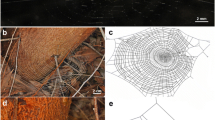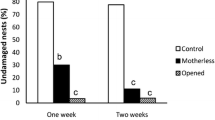Abstract
Female parents ofElasmucha dorsalis attend their offspring and show specific sequential defensive behavior when disturbed. Intense responses of brooding females such as wing fanning were usually triggered by exposure to crushed nymphs. Maternal care continued for a long time, sometimes into the fourth or last nymphal instar. Female removal experiments showed that maternal defense is highly effective under field conditions. High egg mortality observed in the field was probably due to the predation by an ant,Myrmica ruginodis, which occurred at high densities on the host plant,Aruncus dioicus. Most of the egg masses were found on the leaves subtending axillary inflorescence of the female plants, and nymphs usually aggregated and fed on fruits in the inflorescence. Because the food of nymphs is temporally limited, the female can produce only a single brood. Thus, temporality of food resources as well as a heavy predation pressure may have led to prolonged maternal care.
Similar content being viewed by others
References
Eberhard, W. G. 1975 The ecology and behavior of a subsocial pentatomid bug and two scelionid wasps: Strategy and counterstrategy in a host and its parasites.Smithson. Contrib. Zool. 205: 1–39.
Eickwort, G. C. 1981 Presocial insects. In: H. R. Hermann (ed.)Social insects, Vol. 2. pp. 199–280. Academic Press, New York.
Frost, S. W. & V. R. Haber 1944 A case of parental care in the Heteroptera.Ann. Entomol. Soc. Am. 37: 161–166.
Hasegawa, H. 1967 [Life history of the subsocial bug; egg-guarding behavior ofSastragala esakii] In: K. Iwata, H. Hurukawa & K. Yasumatsu (eds.)Nihon Kontyû-ki IV. pp. 145–178. Kôdansha, Tokyo. (In Japanese)
Hayashi, M. 1987 Parental care observed inAnaxandra gigantea (Heteroptera, Acanthosomatidae).Rostria 38: 569–570. (In Japanese with English summary)
Honbo, Y. & K. Nakamura 1985 Effectiveness of parental care in the bugElasmucha putoni Scott (Hemiptera: Acanthosomidae).Jpn. J. Appl. Ent. Zool. 29: 223–229. (In Japanese with English summary)
Ichikawa, N. 1988 Male brooding behaviour of the giant water bugLethocerus deyrollei Vuillefroy (Hemiptera: Belostomatidae).J. Ethol. 6: 121–127.
Kobayashi, T. 1953 The developmental stages of six species of Japanese Pentatomoidea (Hemiptera).Sci. Rep. Matsuyama Agri. Col. 11: 73–89.
Kudô, S. 1988 Notes on the oviposition site ofElasmucha putoni (Hemiptera, Acanthosomatidae).Kontyû, Tokyo 56: 687–688.
Maschwitz, U. & C. Gutmann 1979 Spur-und Alarmstoffe bei der gefleckten BrutwanzeElasmucha grisea.Insectes Soc. 26: 101–111.
Melber, A. & G. H. Schmidt 1975a Sozialverhalten zweierElasmucha—Arten (Heteroptera: Insecta).Z. Tierpsychol. 39: 403–414.
Melber, A. & G. H. Schmidt 1975b Ökologische Bedeutung des Sozialverhaltens zweierElasmucha—Arten (Heteroptera: Insekta).Oecologia (Berl.) 18: 121–128.
Melber, A. & G. H. Schmidt 1977 Sozialphänomene bei Heteropteren.Zoologica 127: 19–53.
Melber, A., L. Hölscher & G. H. Schmidt 1980 Further studies on the social behaviour and its ecological significance inElasmucha grisea L. (Hem.—Het.: Acanthosomatidae).Zool. Anz., Jena 205: 27–38.
Melber, A., H. G. Klindworth & G. H. Schmidt 1981 Saisonaler Wirtspflanzenwechsel bei der baumbewohnenden WanzeElasmucha grisea L. (Heteroptera: Acanthosomatidae).Z. ang. Ent. 91: 55–62.
Morisita, M. 1959 Measuring of the dispersion of individuals and analysis of the distributional patterns.Mem. Facul. Sci. Kyushu Univ. Ser. E2: 215–235.
Odhiambo, T. R. 1960 Parental care in bugs and non-social insects.New-Scientist 8: 449–451.
Parker, A. H. 1965 The maternal behaviour ofPisilus tipuliformis Fabricius (Hemiptera: Reduviidae).Entomol. exp. appl. 8; 13–19.
Smith, R. L. 1976 Male brooding behavior of the water bugAbedus herberti (Hemiptera: Belostomatidae).Ann. Entomol. Soc. Am. 69: 740–747.
Strawinski, K. 1951 On the biological dependency of Hemiptera-Heteroptera on trees and shrubs.Ann. Univ. Mariae Curie-Sklod. Lublin (C) 6: 149–164.
Tachikawa, S. 1971 Studies on parental care of Heteroptera, I. OnElasmucha putoni of Japan and otherElasmucha spp.J. agr. Sci. Tokyo Nogyo Daigaku, (Comm. Numb. 80th Anniv. Found.): 24–34. (In Japanese with English summary)
Takahashi, R. 1921 Parental care ofCantao ocellatus Thunberg.Trans. Nat. Hist. Soc. Formosa 11: 81–86. (In Japanese)
Tallamy, D. W. 1985 “Egg dumping” in lace bugs (Gargaphia solani, Hemiptera: Tingidae).Behav. Ecol. Sociobiol. 17: 357–362.
Tallamy, D. W. & R. F. Denno 1981 Maternal care inGargaphia solani (Hemiptera: Tingidae).Anim. Behav. 29: 771–778.
Tallamy, D. W. & T. K. Wood 1986 Convergence patterns in subsocial insects.Ann. Rev. Entomol. 31: 369–390.
Wilson, E. O. 1971 The insect societies. Harvard Univ. Press. 548 pp.
Wilson, E. O. 1975 Sociobiology. The new synthesis. Harvard Univ. Press. 697 pp.
Wood, T. K. 1976 Alarm behavior of brooding femaleUmbonia crassicornis (Homoptera): Membracidae).Ann. Entomol. Soc. Am. 69: 340–344.
Author information
Authors and Affiliations
About this article
Cite this article
Kudô, Si., Satô, M. & Ôhara, M. Prolonged maternal care inElasmucha dorsalis (Heteroptera: Acanthosomatidae). J. Ethol. 7, 75–81 (1989). https://doi.org/10.1007/BF02350027
Received:
Accepted:
Issue Date:
DOI: https://doi.org/10.1007/BF02350027




